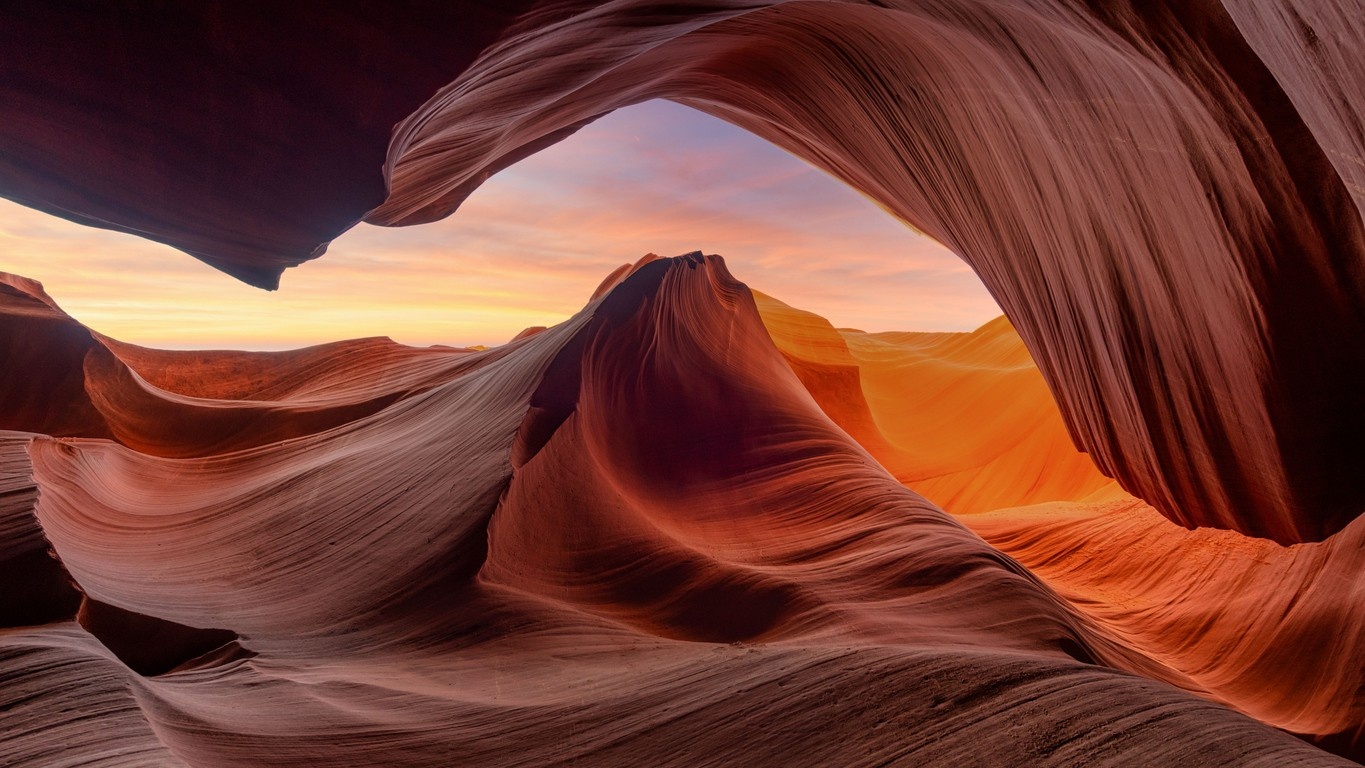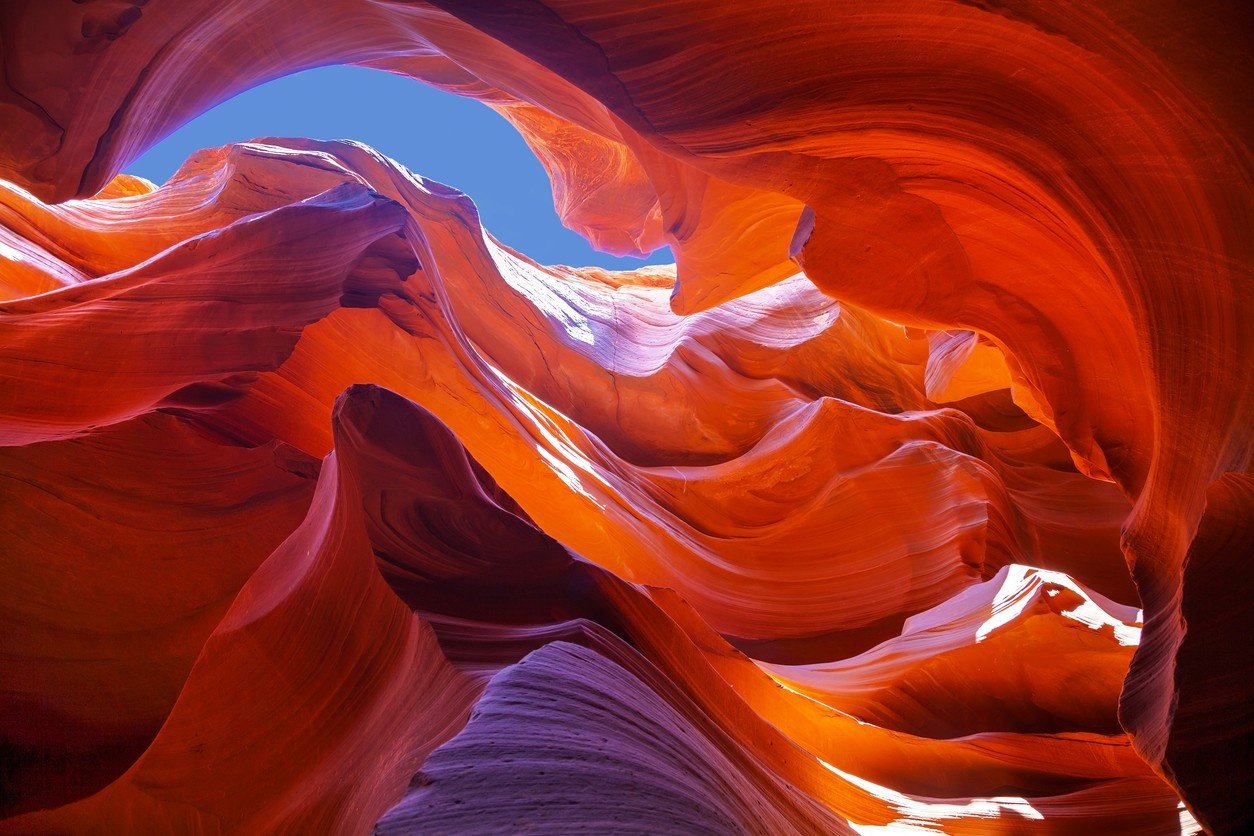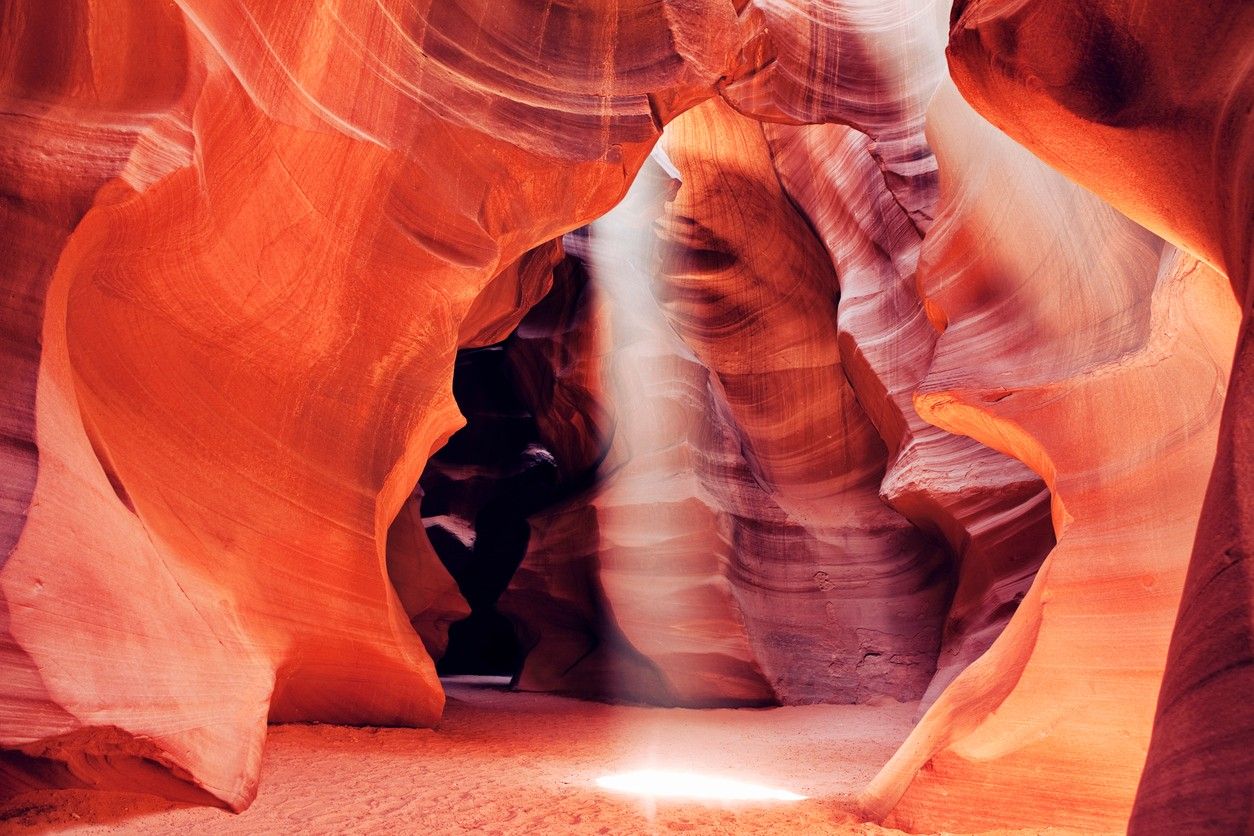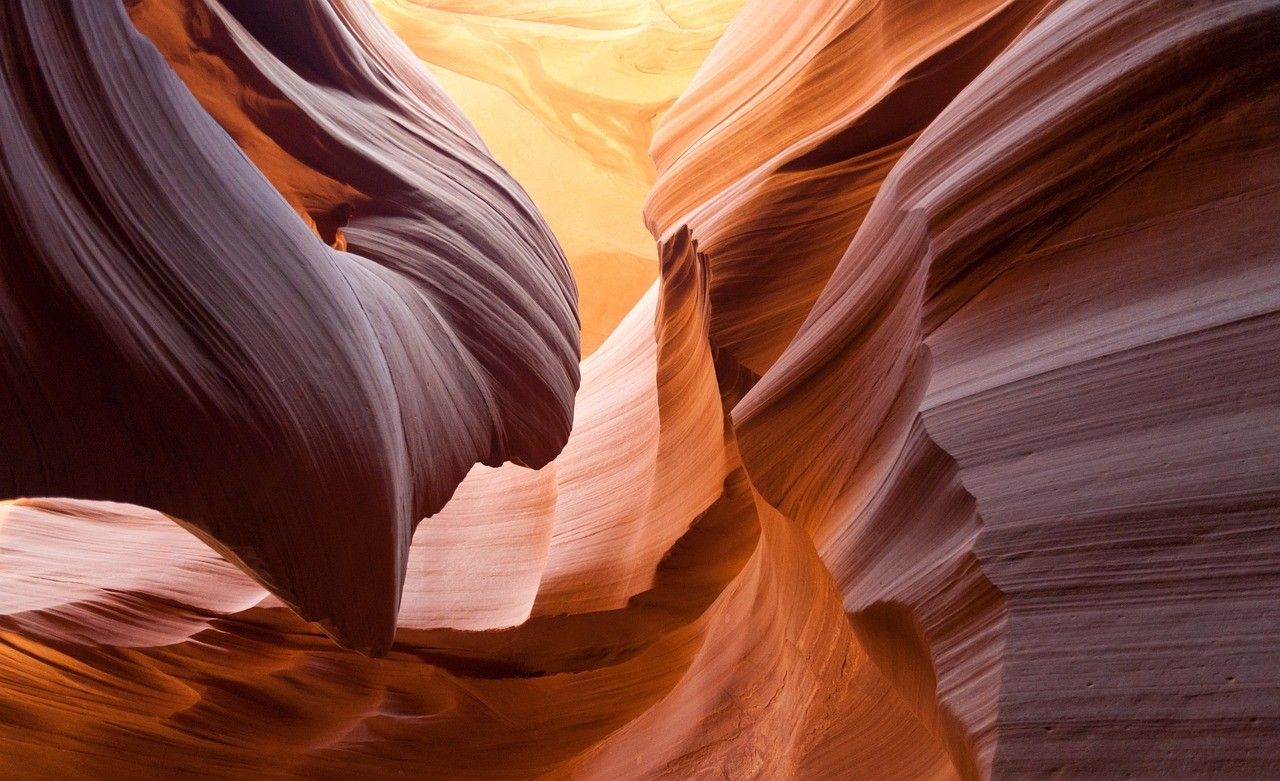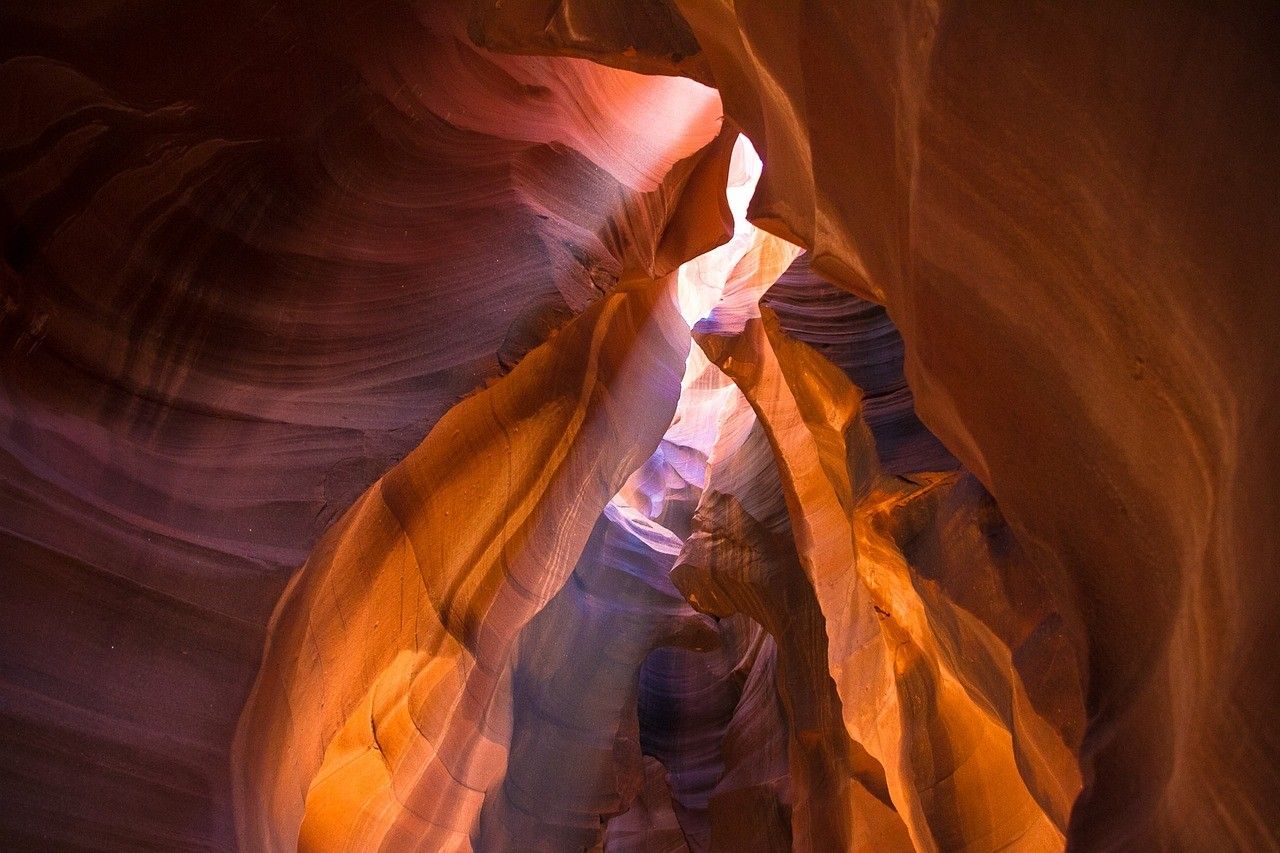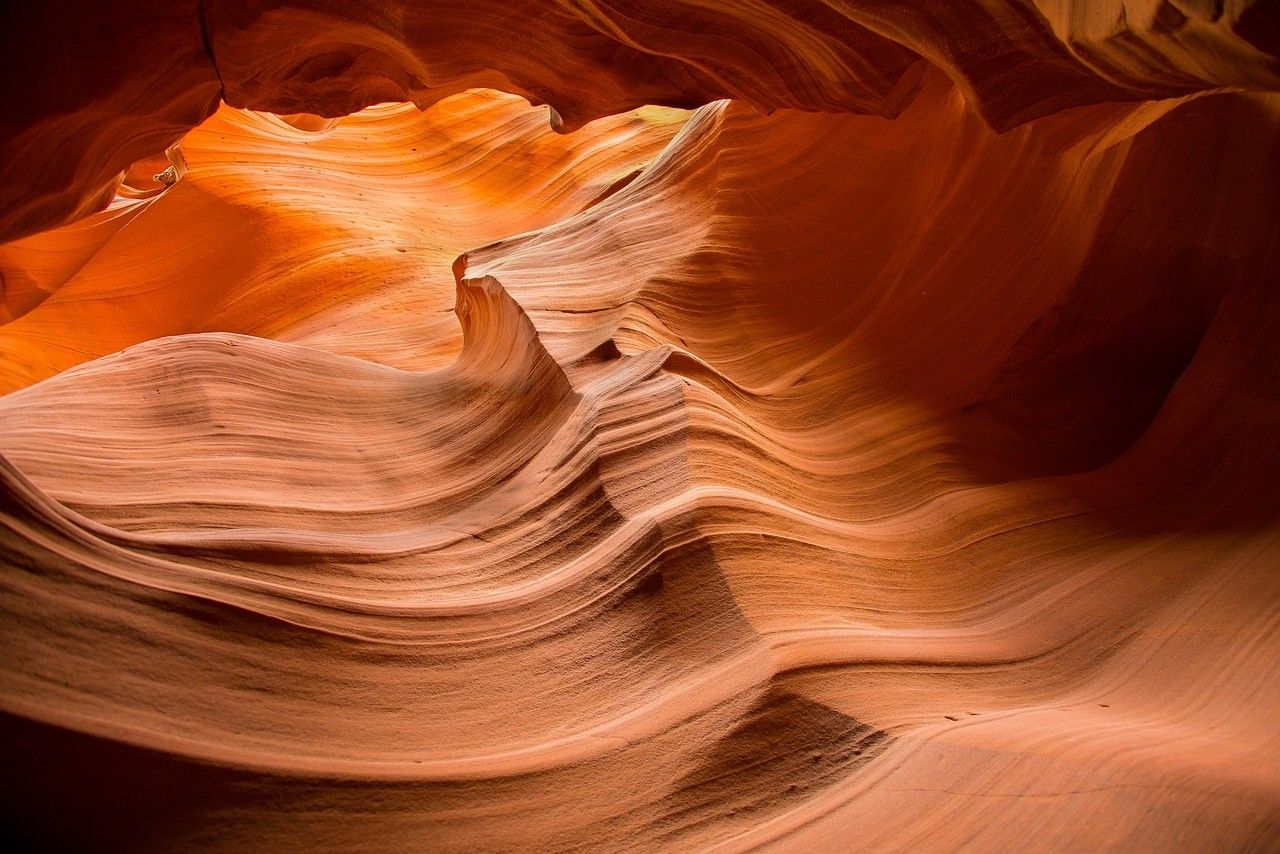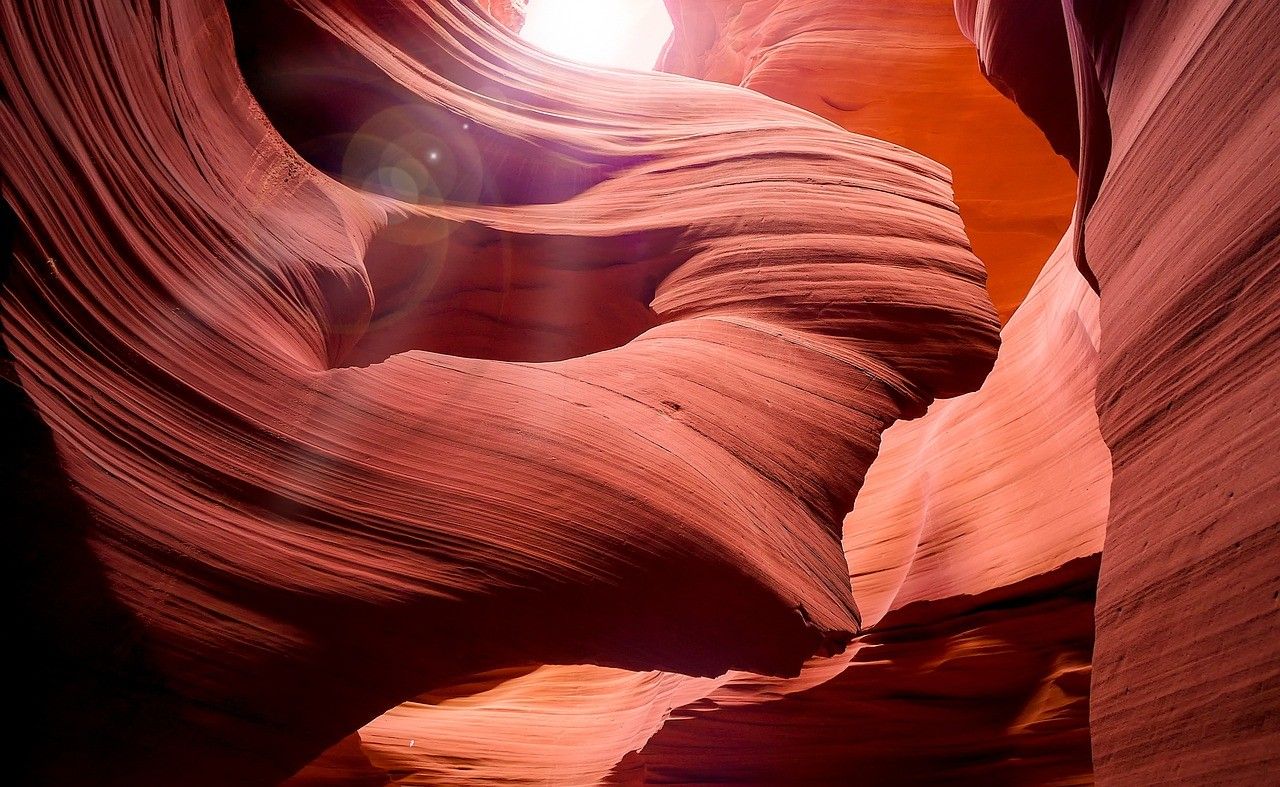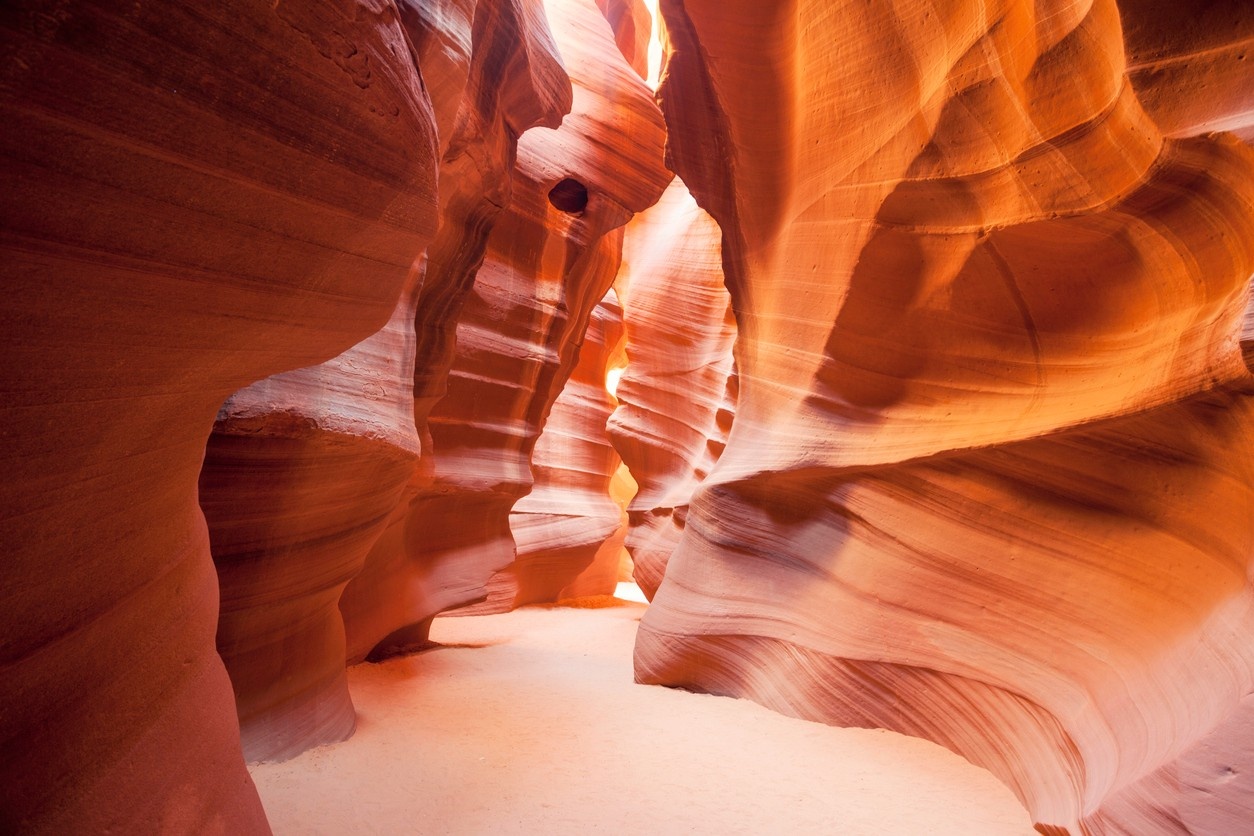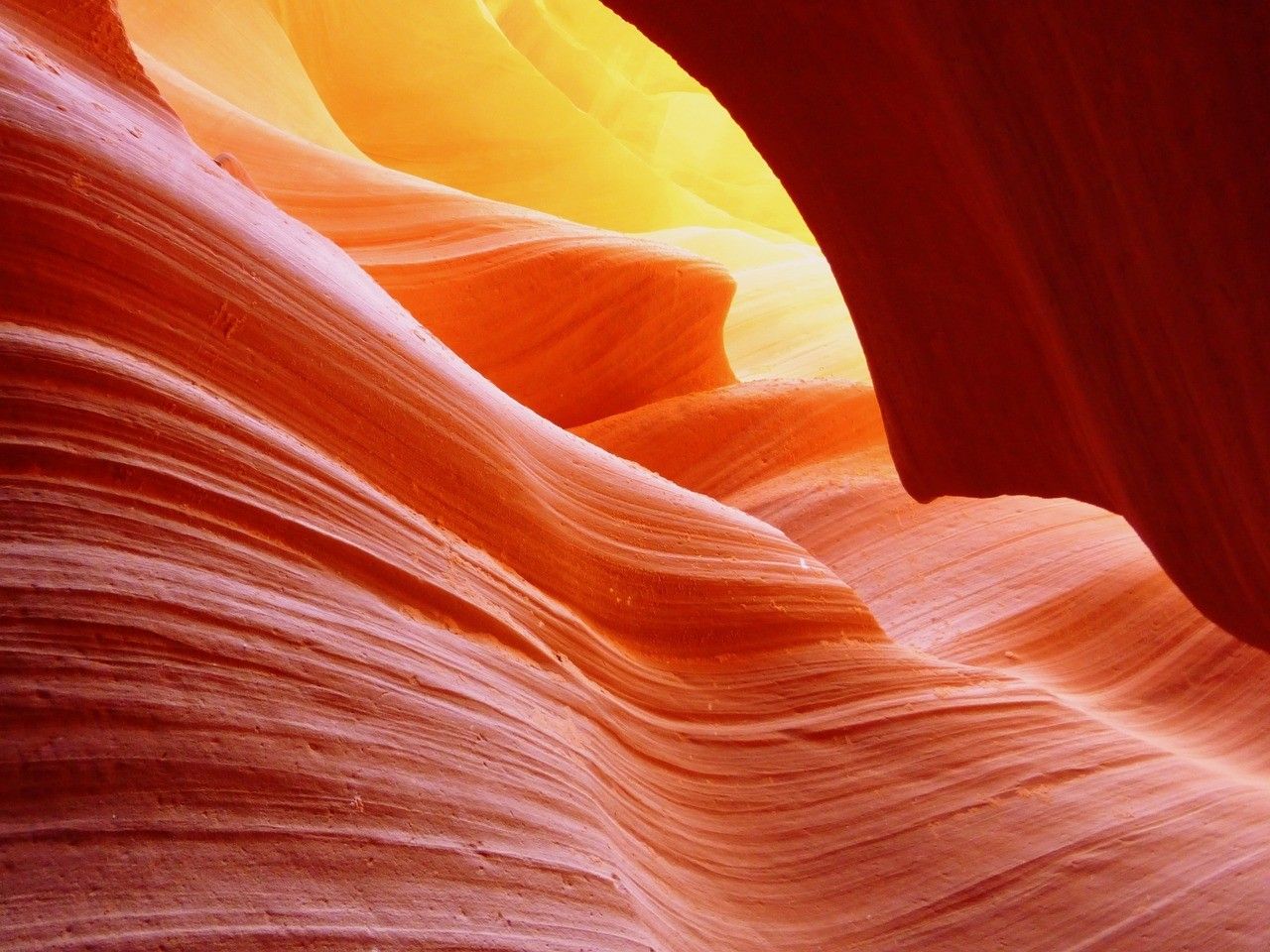Antelope Canyon, a natural wonder nestled within the Navajo Nation in northern Arizona, USA, is a breathtaking sight to behold. This slot canyon, carved out of the Navajo Sandstone by the relentless forces of water and wind over millions of years, is divided into two distinct sections: Upper Antelope Canyon and Lower Antelope Canyon. Each section offers its own unique experience, with smooth, undulating walls and ethereal light beams that pierce through the narrow openings above, creating an otherworldly atmosphere. The Navajo name for Upper Antelope Canyon, "Tsé bighánílíní," translates to "the place where water runs through rocks." This section of the canyon is renowned for its iconic light beams that appear during the summer months, typically from May to September. These captivating light beams are created when the sun is high in the sky, and its rays penetrate the narrow openings above, illuminating the canyon's interior with a magical, ethereal glow. The light dances off the canyon's walls, creating a spectacular display of colours and shadows that leave visitors in awe.
In contrast, Lower Antelope Canyon, known as "Hazdistazí" or "spiral rock arches" in the Navajo language, presents a more challenging yet equally rewarding experience. This section of the canyon is narrower and more intricate than its upper counterpart, with steep ladders and tight passageways that visitors must navigate. However, the effort is well worth it, as Lower Antelope Canyon reveals a display of swirling, sculptured walls that seem to defy the laws of nature. The canyon's curves and contours create an almost surreal landscape, with each turn revealing new and exciting formations. Antelope Canyon is not only a photographer's paradise but also a sacred site for the Navajo people. The canyon holds immense spiritual significance, and the Navajo believe that the spirits of their ancestors continue to reside within its walls. Visitors are asked to respect the canyon and refrain from touching the walls or removing any objects from the site, as a way of honoring the canyon's sacred nature and preserving its beauty for future generations.
Geology & Formation of Antelope Canyon
The formation of Antelope Canyon is a testament to the incredible power and artistry of nature. This geological masterpiece is situated within the Navajo Sandstone formation, which was deposited during the Late Triassic and Early Jurassic periods, approximately 190 to 136 million years ago. At that time, the area was a vast desert, characterised by towering dunes that reached hundreds of feet in height. For millions of years, these dunes were compressed and cemented together by the immense weight of overlying sediments and the presence of iron oxide and calcium carbonate. This process transformed the loose sand into the Navajo Sandstone, a thick layer of rock renowned for its striking red and orange hues. The iron oxide within the sandstone is responsible for these vibrant colours, which are further enhanced by the interplay of light and shadow within the canyon.
The creation of Antelope Canyon itself began around 5 to 6 million years ago, as the Colorado Plateau began to uplift and the Colorado River started to carve its way through the landscape. As the river cut deeper into the plateau, it exposed the layers of Navajo Sandstone below, setting the stage for the formation of the canyon. Over time, the occasional flash floods that occur in the region began to erode the sandstone, gradually sculpting the narrow, twisting passageways that define Antelope Canyon. These flash floods can be incredibly powerful, with water speeds reaching up to 150 miles per hour and carrying large amounts of sand and rock debris. As the floodwaters rush through the narrow passageways, they sculpt the soft sandstone into the smooth, swirling shapes that characterise the canyon, creating an almost otherworldly landscape. The constant erosion and deposition of sand and rock particles also contribute to the canyon's unique colour patterns, with layers of red, orange, and purple hues that shift and change with the light. The angle of the sun, the time of day, and even the season can dramatically alter the appearance of the canyon, creating a dynamic and ever-changing visual experience.
Antelope Canyon continues to evolve and change with each passing flood. The canyon's walls are constantly being reshaped and smoothed by the force of the water, creating an ever-changing landscape that is both beautiful and dynamic. The delicate balance between the erosive power of the flash floods and the resilience of the Navajo Sandstone has resulted in a natural wonder that is unlike any other on Earth. The geology and formation of Antelope Canyon serve as a humbling reminder of the immense power and timeless tales of nature. The canyon's intricate beauty and mesmerising shapes are the result of millions of years of slow, steady change, driven by the relentless forces of water and wind. For those who visit Antelope Canyon, the opportunity to witness this ongoing geological process firsthand is an unforgettable experience, one that leaves a lasting impression of the raw beauty and power of the natural world.
Visiting The Canyon
Visiting Antelope Canyon is an unforgettable experience that offers a unique glimpse into the raw beauty and power of nature. However, due to the canyon's location within the Navajo Nation, there are important guidelines and regulations that visitors must follow to ensure a safe and respectful experience.
To access Antelope Canyon, visitors must book a guided tour led by an authorised Navajo tour operator. These tours are designed to prioritise the safety of visitors while minimising the impact on the delicate ecosystem of the canyon. Attempting to explore the canyon independently is strictly prohibited and can result in fines and legal consequences. Several reputable tour operators offer guided tours of both Upper and Lower Antelope Canyon, each with their own unique itineraries and pricing structures. Popular tour operators include Antelope Canyon Tours, Antelope Canyon Navajo Tours, and Ken's Tours. When planning a visit to Antelope Canyon, it is crucial to book tours well in advance, especially during the peak season from May to September, as they can fill up quickly.
Before embarking on a tour, visitors should be well-prepared for the experience. Antelope Canyon is located in a remote area of the Navajo Nation, with limited amenities and services available. Visitors should bring plenty of water, snacks, and sun protection, as well as sturdy shoes and appropriate clothing for hiking. The canyon's interior can be cool and shaded, even on hot days, so layers are recommended. During the tour, visitors will be guided through the canyon by a knowledgeable Navajo guide who will share fascinating stories and insights about the canyon's history, geology, and cultural significance. Tours typically last between 1-2 hours, depending on the specific itinerary and group size. Visitors should be prepared for some physical exertion during the tour, particularly in Lower Antelope Canyon, which involves climbing ladders and navigating narrow passageways. However, tour operators are experienced in accommodating visitors of all ages and abilities, and will provide assistance and support as needed. The guides' expertise and knowledge of the canyon ensure a safe and enjoyable experience for all.
As visitors make their way through the canyon, they will be treated to a visual feast of stunning light beams, swirling rock formations, and vibrant colours. The canyon's smooth, undulating walls and ethereal light create an almost surreal atmosphere, transporting visitors to another world. The interplay of light and shadow within the canyon is a photographer's dream, with countless opportunities to capture breathtaking images. Throughout the tour, visitors will also learn about the cultural significance of Antelope Canyon to the Navajo people. The canyon is a sacred site, and visitors are asked to respect the canyon and its inhabitants by staying on designated paths and refraining from touching or disturbing the delicate ecosystem. By following these guidelines and listening to the wisdom of the Navajo guides, visitors can gain a deeper appreciation for the canyon's beauty and the rich cultural heritage of the Navajo Nation.
Photography in Antelope Canyon
Antelope Canyon is a photographer's paradise, offering a stunning array of light beams, swirling rock formations, and vibrant colours that create endless opportunities for breathtaking images. However, capturing the canyon's beauty can be challenging, particularly for those new to landscape photography.
One of the primary challenges of photographing Antelope Canyon is the dynamic range of light within the canyon. The narrow openings above allow bright sunlight to penetrate the canyon, creating harsh shadows and highlights that can be difficult to capture in a single exposure. To overcome this challenge, many photographers employ techniques such as bracketing and high-dynamic range (HDR) photography. Bracketing involves taking multiple exposures of the same scene at different shutter speeds, which can then be blended in post-processing to create a single image with a wider dynamic range. HDR photography, on the other hand, involves taking multiple exposures and combining them in-camera or in post-processing to create a single image with a higher dynamic range. These techniques allow photographers to capture the full range of light within the canyon, from the deepest shadows to the brightest highlights.
Another challenge of photographing Antelope Canyon is the limited space and time available during guided tours. The canyon can be crowded with other visitors, and tour guides must keep the group moving to ensure that everyone has a chance to see and photograph the canyon's most iconic features. To make the most of the limited time, photographers should come prepared with the right gear and techniques. A wide-angle lens is essential for capturing the canyon's sweeping curves and towering walls, while a tripod can help achieve sharp, blur-free images in low-light conditions. Photographers should also be familiar with their camera's settings and be able to adjust them quickly to adapt to the changing light conditions within the canyon.
Communicating with the tour guide is also essential for photographers. Many guides are experienced photographers themselves and can offer valuable tips and insights on how to capture the best shots of the canyon. They can also help position photographers in the best spots to capture iconic shots, such as the famous light beams in Upper Antelope Canyon.
In addition to the technical challenges, photographers must also be mindful of the cultural significance of Antelope Canyon to the Navajo people. The canyon is a sacred site, and visitors are asked to respect the canyon and its inhabitants by following the guidelines set by the tour operators, staying on designated paths, and refraining from touching or disturbing the delicate ecosystem.
Despite the challenges, the rewards of photographing Antelope Canyon are immeasurable. The canyon's unique beauty and ever-changing light create endless opportunities for stunning images that capture the raw power and artistry of nature. From the swirling patterns of the canyon's walls to the ethereal light beams that pierce the darkness, every moment in Antelope Canyon is a photographer's dream come true. For those who are passionate about photography, a visit to Antelope Canyon is an unforgettable experience that offers the chance to capture some of the most stunning images of the natural world. With the right preparation, techniques, and mindset, photographers can create images that not only showcase the canyon's beauty but also evoke a sense of wonder and awe at the incredible power and artistry of nature.
What Does Antelope Canyon Mean for the Navajo People?
Antelope Canyon holds immense cultural and spiritual significance for the Navajo people, who have called the surrounding area home for centuries. The canyon is not merely a natural wonder but a sacred site that is deeply intertwined with Navajo history, traditions, and beliefs. According to Navajo legend, Antelope Canyon was created by the wind and water spirits, who carved the canyon's smooth, swirling walls as a gift to the Navajo people. The canyon is also associated with the Navajo god of thunder, lightning, and rain, known as Tó Neinilii. These spiritual connections imbue the canyon with a sense of reverence and sacredness that is palpable to all who visit.
For the Navajo, Antelope Canyon is a place of healing and renewal, where one can connect with the spirits of the earth and the ancestors. Many Navajo families have traditional ties to the canyon, with some still performing sacred ceremonies and rituals within its walls. These ceremonies, which are not open to the public, are an essential part of Navajo cultural heritage and help maintain the spiritual balance and harmony of the canyon. The Navajo's deep respect for the natural world is reflected in their traditional practices of sustainable land management, which have helped preserve the delicate ecosystem of Antelope Canyon and the surrounding area for generations. The Navajo view all living things as interconnected and interdependent, and they strive to live in harmony with the land and its creatures.
In recent years, the Navajo Nation has worked to balance the demands of tourism with the need to protect and preserve the cultural and spiritual significance of Antelope Canyon. The Navajo Nation Parks and Recreation Department oversees the management of the canyon, and all tours are conducted by authorised Navajo tour operators who are trained in the canyon's history, geology, and cultural significance. These tour operators play a crucial role in educating visitors about the canyon's cultural significance and ensuring that visitors respect the canyon and its inhabitants. They share stories and insights about Navajo history and beliefs, helping visitors gain a deeper appreciation for the canyon's sacred nature. Visitors to Antelope Canyon are asked to respect the canyon and its inhabitants by following the guidelines set by the tour operators, staying on designated paths, and refraining from touching or disturbing the delicate ecosystem. They are also encouraged to learn about Navajo culture and history and to support the local Navajo community by purchasing authentic Navajo arts and crafts.
FAQs
Can I visit Antelope Canyon on my own?
No, access to Antelope Canyon is restricted, and visitors can only enter with authorised Navajo guides. Guided tours are mandatory.
What is the difference between Upper and Lower Antelope Canyon?
Upper Antelope Canyon is at ground level, requiring no climbing, and is known for its light beams. Lower Antelope Canyon is longer, narrower, and requires climbing stairs. It is more challenging but draws many photographers.
When is the best time to visit Antelope Canyon?
The best time to visit depends on what you want to see. Light beams in Upper Antelope Canyon are best from March to October, with peak visibility during summer midday. Lower Antelope Canyon has better lighting in the early hours and late mornings.
How do I book a tour of Antelope Canyon?
Booking a guided tour is essential to visit Antelope Canyon. Many tour operators offer tours, and it is recommended to book in advance, especially during peak season.
Are there any cultural or environmental considerations when visiting?
Yes, Antelope Canyon is sacred to the Navajo Nation. Visitors should treat the land with respect, follow their guide's instructions, and refrain from touching the canyon walls or disturbing the environment.
Can I visit Antelope Canyon in the rain?
Antelope Canyon may close during or immediately after heavy rain due to the risk of flash flooding. The Navajo Parks and Recreation Department or individual tour operators may close the canyon based on weather conditions.
What should I bring on my Antelope Canyon tour?
Bring water, snacks, sunscreen, and appropriate footwear. Cameras are allowed, but tripods may be restricted, especially in Lower Antelope Canyon.
Are there other attractions nearby worth visiting?
Yes, nearby attractions include Horseshoe Bend, Lake Powell, and the Navajo National Monument, which offer additional opportunities for sightseeing and learning about the area's natural and cultural heritage.
Related Articles

Let us know you agree to cookies
We use marketing, analytical and functional cookies as well as similar technologies to give you the best experience. Third parties, including social media platforms, often place tracking cookies on our site to show you personalised adverts outside of our website.
We store your cookie preferences for two years and you can edit your preferences via ‘manage cookies’ or through the cookie policy at the bottom of every page. For more information, please see our cookie policy.
